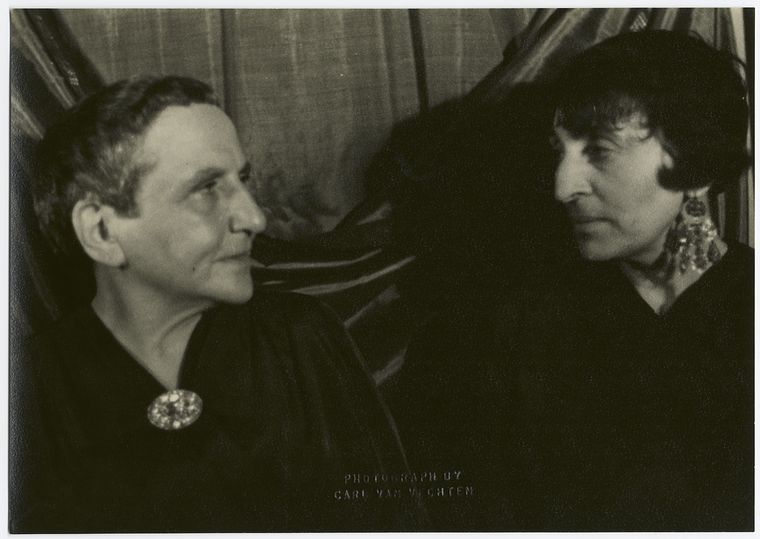A few years ago I attended a play at an off-beat Seattle theater named Alice B. Toklas, and mentioned to the doorperson as I left that Toklas was at one time a Seattle resident.
Toklas was famous, of course, as the life-long companion of Gertrude Stein. As a team, Stein and Toklas contributed to the cultural vortex of 1920s Paris. Their atelier at 27 Rue de Fleurus housed Picasso and Matisse paintings while serving as the meeting place for literary and musical giants.
Alice was born in California. Her earliest years were spent in San Francisco where she attended private schools. As a child she travelled to Europe, while her family members established mining and mercantile businesses in Washington state. Her father’s businesses — which suffered two fires — caused the family to move north in the early 1890s.
Alice attended Miss Mary Cochrane’s School in Seattle. In her autobiography, What is Remembered, she wrote that Miss Cochrane “and her two sisters were the staff, and all these three knew was what they taught us.” Alice Toklas’ mother was an ardent gardener, and their First Hill home was ablaze with a variety of flowers. Alice recalled bouquets made up of Homer roses, hops, dwarf yellow pansies, periwinkles, and sweet peas.
A touching vignette was Toklas’ memory of visiting a hop ranch in the Snoqualmie Valley. A young Native American woman came to their door and asked for a pair of shoes in which to bury her child. A friend of the Toklases provided a pair of small high-heeled white satin slippers.
Alice attended the University of Washington, which was then at the downtown site of the present Fairmont-Olympic Hotel. She described her only year at the University as “lively.” Dances and parties on the shores of Lake Washington were highlights of her brief academic experience.
Just before the outbreak of the Spanish-American War (1898), Mrs. Toklas’s poor health caused the family to return to California. Alice returned to Seattle occasionally, once to give a piano recital with her friend Elizabeth Hansen.
By 1905 Toklas had briefly met Gertrude Stein and her brother Leo in San Francisco. In September, 1907, Alice sailed for France. Her name will forever be linked with the Gertrude Stein circle, the Dadaists, and string of anecdotes surrounding Ernest Hemingway, James and Nora Joyce, Ezra Pound, Sylvia Beach, and others. Before all that a young Alice B. Toklas was an obscure, happy Seattleite.
Discover more from Post Alley
Subscribe to get the latest posts sent to your email.

What a great historic anecdote! Wonderful to learn about her connection to Seattle.
In the late 1960’s through the 70’s marijuana brownies were known as ‘Alice B Toklas’ brownies in the common vernacular of my peer group. This article reminded me of that and pushed me down the path to finally understanding why. Apparently, Toklas included a recipe for Haschish Fudge’ in a cookbook she had agreed for Harper’s to publish in 1954. This was later popularized in the 1968 movie ‘I love you, Alice B Toklas’, which I had completely forgotten about. I suspect that I’m one of many in my generation who were familiar with the name long before we had any appreciation for the person.
The cannabis brownie recipe in “The Alice B. Toklas Cook Book” comes from British-Canadian artist Brion Gysin. While much of Toklas’s book is a delightful memoir-cum-cookbook full of cookery and reminiscences of her life with Stein (“Murder in the Kitchen” is a great one), it has always seemed to me that she ran out of steam and so the latter parts of the book comprise recipes from her friends. Many of these latter recipes are of little culinary value and are more interesting for what they say about the contributor–Gysin’s “Haschich Fudge” is a case in point. If you don’t have the book at hand, the recipe can be easily googled–and rather than something out of Baudelaire, the recipe would result in something like your grandmother’s fruitcake–desiccated, grainy, and overspiced.
Thank you, Junius, for the interesting story.
As I’m sure you found, The Autobiography of Alice B. Toklas (1933) skips Alice’s time in Seattle and jumps directly from her childhood in San Francisco to her departure for Paris in 1907. Despite its title, the book was not an autobiography of Alice B. Toklas but was written by Gertrude Stein in the voice of Alice and was really an autobiography of Stein for the Greater Glory of Gertrude. In that book, Stein told this about herself (in Alice’s voice):
”I may say that only three times in my life have I met a genius and each time a bell within me rang and I was not mistaken, and I may say in each case it was before there was any general recognition of the quality of genius in them. The three geniuses of whom I wish to speak are Gertrude Stein, Pablo Picasso and Alfred Whitehead.”